|
|
|
Sort Order |
|
|
|
Items / Page
|
|
|
|
|
|
|
| Srl | Item |
| 1 |
ID:
147858
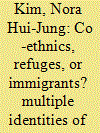

|
|
|
|
|
| Summary/Abstract |
The articles in this Special Issue critically examine a number of key aspects of North Koreans who have fled their home state and sought a new life in the ‘other’ Korea. The articles examine the landscape of government policy for North Koreans, the role of civil society and the media, and the lived experiences of North Koreans in South Korean society. The central theme of the Special Issue is the contentious politics of choosing and articulating identity categories; what kinds and by whom identity categories are imposed upon North Koreans and how North Koreans interpret these identity categories and strategically employ them. The Special Issue makes significant empirical and theoretical contributions to our understanding of North Koreans in South Korea and on the complex issue of ethnic boundary drawing.
|
|
|
|
|
|
|
|
|
|
|
|
|
|
|
|
| 2 |
ID:
147871
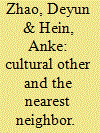

|
|
|
|
|
| Summary/Abstract |
Greater Liangshan is one of the few regions of China where, among 70–80% of Nuosu, the Han are a minority. Instead of the much more common phenomenon of ‘Hanification,’ here we can observe Han absorbing traits of other ethnic groups. Based on two seasons of fieldwork combined with historical texts and previous ethnographic research, this paper discusses this phenomenon, raising issues of ethnic identity and the influence of local circumstances on interethnic relations. Throughout the paper, it becomes clear that there is no simple dichotomy between Han and Nuosu, but that the situation is considerably more complex. The Nuosu fall into several castes, and the Han settlers had two different experiences. Some were captured as slaves and tried to become fully Nuosu. Ethnic relations in the Greater Liangshan are thus highly complex and require more research to be thoroughly understood.
|
|
|
|
|
|
|
|
|
|
|
|
|
|
|
|
| 3 |
ID:
147872
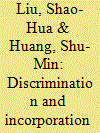

|
|
|
|
|
| Summary/Abstract |
This paper examines contemporary developments among Taiwan’s indigenous Austronesian peoples. We have reviewed major policy changes mainly since the 1980s and their impacts on later developments – both the positive improvements in general well-being and the persistence of ingrained problems among them. Major findings indicate two growing trends among Taiwanese Austronesians. One is the rise of interest in their cultures and efforts to preserve and restore selected indigenous customs and practices. The other trend is a continuous outflow of the indigenes from traditional tribal communities to urban centers for better employment, education, or health care. Their increasing urbanization also contributes to more inter-ethnic marriages and the loss of indigenous languages and practices. The case of Taiwanese Austronesians illustrates the impacts historical and politico-economic processes are having on indigenous peoples.
|
|
|
|
|
|
|
|
|
|
|
|
|
|
|
|
| 4 |
ID:
147869
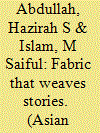

|
|
|
|
|
| Summary/Abstract |
This article examines the process of identity construction among the Iban indigenous people of Sarawak in Malaysia through pua kumbu – their sacred and ritual cloth. Although the Ibans are popularly known for their headhunting practices and longhouse dwellings, these cultural practices are in major decline and therefore pua kumbu is brought to the forefront as a significant means of identity construction. By illustrating the meanings, narratives, and ceremonies associated with pua kumbu, this article demonstrates that pua kumbu is not just a piece of sacred or ritual cloth; rather, it has significant meanings in the everyday life of the Ibans. It connects the Ibans with distinctly eternal meanings of their life and cosmology, past histories, and their connections to the physical environment. It thus helps the process of maintaining a boundary and identity construction of the Ibans by distinguishing between ‘us and them’ – the Ibans and others.
|
|
|
|
|
|
|
|
|
|
|
|
|
|
|
|
| 5 |
ID:
147864
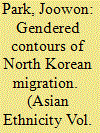

|
|
|
|
|
| Summary/Abstract |
This article examines the gendered and sexualized contours of North Korean experiences in South Korea at a time when nearly 70% of the North Korean emigrants are women. South Korean television shows – e.g. reality programs – and marriage matchmaking organizations seek to portray North Korean women in a ‘positive’ way to the South Korean public, although, as this article will illustrate, these representations are of a very particular, sexualized kind. These representations are sometimes negative, and there is stigma attached to North Korean women, in which South Koreans assume, for example, that they are victims of human trafficking or that they have had relations with Chinese men during their migration. Furthermore, poor nutrition and other forms of structural violence in North Korea have molded North Korean bodies; there are often physical disparities between North and South Koreans. In South Korean society where short height is viewed as undesirable and where idealized, surgical notions of beauty dominate, the violence of gendered phenotypical normalization mark North Korean bodies as smaller, foreign, and strange. Based on ethnographic research in South Korea, this article argues that these gendered contours of North Korean migration amount to a different sort of structural violence in South Korea.
|
|
|
|
|
|
|
|
|
|
|
|
|
|
|
|
| 6 |
ID:
147860
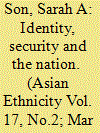

|
|
|
|
|
| Summary/Abstract |
From the Cold War era of the ‘veteran heroes’ to the present view of escaped North Koreans in terms more akin to ‘refugees’ and sometimes even just ‘migrants’, perceptions of North Korean defectors in South Korea have changed as swiftly as the number and origins of Northerners entering the South have expanded. At the same time, government policy for these ethnic ‘brethren’ has evolved considerably, particularly as South Korea has seen fundamental shifts in its independent identity, with important repercussions for the way its citizens view themselves as a collective. This article explores some of the key influences behind changes to policy and perceptions regarding North Korean people in South Korea over the period from 1997 to 2012, by applying international relations theory on national identity and its role in policy formation and change through the need to secure different parameters within that identity.
|
|
|
|
|
|
|
|
|
|
|
|
|
|
|
|
| 7 |
ID:
147866
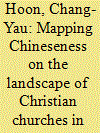

|
|
|
|
|
| Summary/Abstract |
Scholarship on the Chinese Indonesian community has largely been concerned with the tensions between the community and the majority non-Chinese (or pribumi). The fault lines were usually examined against the background of Suharto’s assimilation policy, the 1998 anti-Chinese riots, the stark imbalance of the nation’s wealth within this minority group, and Chinese loyalty – or chauvinism – in the time of nation-building, and in the face of the rise of modern China. Little attention has been given to Christianity as offering a shelter for the inconspicuous propagation of Chineseness; particularly in terms of the conduct of services in Chinese, the teaching of the language, and business-management leadership. The network of Chinese churches locally, and extending internationally beyond Indonesia, represents a rich field for further scholarship. This article sets out an epistemological map in the service of such research.
|
|
|
|
|
|
|
|
|
|
|
|
|
|
|
|
| 8 |
ID:
147862


|
|
|
|
|
| Summary/Abstract |
This article compares North Korean immigrants and foreign bride policies in South Korea. Despite being constructed as distinctive policy target groups, North Korean settlement and foreign bride incorporation policies exhibit striking similarities. The similarities result from the way policy problems are identified and certain solutions are justified; both North Korean immigrants and foreign brides are constructed a burden on welfare and as potential threats to social stability. Policy solutions are justified as they are designed to transform North Korean immigrants and foreign brides into ‘normal’ South Korean citizens. The major difference between two sets of policies lies in assumptions regarding cultural differences. Foreign brides are assumed to carry practices that are foreign and alien to Koreans, while North Korean immigrants are presumed to carry ‘authentic’ and ‘traditional’ Korean culture. Foreign brides’ cultures are visible and alien to South Koreans, and therefore are addressed under the banner of multiculturalism policies. North Korean immigrants are excluded from such policies. This exclusion reflects and reproduces the view of a Korean nation bounded by ethnic and cultural homogeneity.
|
|
|
|
|
|
|
|
|
|
|
|
|
|
|
|
| 9 |
ID:
147863


|
|
|
|
|
| Summary/Abstract |
This paper explores how institutional service provision for North Koreans in South Korea contributes to formulating specific kinds of North Korean subjectivity. North Korean matters are still controversial and riddled with various political issues, including the Cold War, ethnic homogeneity, and neoliberal changes. There has been significant critique on over-competition, resource misuse, and inadequate services for this population in South Korea to date. Semi-government resettlement agencies called Hana Centers have attempted to standardize and individualize service provision to North Koreans since 2009 reflecting neoliberal welfare trend in South Korea. In the space where the stated policy and actual practices create gap in-between, the values of practicality and neutrality take precedence in operating the Hana Centers. Bureaucratic practices of Hana Centers on the ground reveal contradictory and divergent operations, featuring street-level bureaucracy and localized governmentality. This paper specifically attends to the depoliticizing and decontextualizing effects that the Hana Centers exert in configuring North Korean subjectivity, with detailed descriptions of bureaucratic operations.
|
|
|
|
|
|
|
|
|
|
|
|
|
|
|
|
| 10 |
ID:
147867
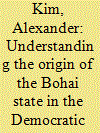

|
|
|
|
|
| Summary/Abstract |
The state of Bohai (on Korean reading – Parhae, 발해) existed in what is modern Russian Primorye region (Приморский край/Maritime Region), North Korea and Northeastern China, from the late seventh to the early tenth centuries AD. It played an important role in the history of the area as a major regional power for over two centuries. Recently, the history of Bohai has begun to attract scholarly interest. However, North Korean studies of Bohai remain basically almost unknown in the Western world. In this article, I present the history of Bohai studies in the Democratic People’s Republic of Korea (DPRK). In this article, I analyze not only North Korean studies of Bohai but also the opinions of the Korean scholars on the subject. They are rather specific for North Koreans who have unique access to the archaeological and historical materials on Bohai but are also subjected to unusually severe political pressures. The history of Bohai has now become an object of active political games which are related to territorial claims based on alleged archaeological and historical material. This situation increases the general interest in Bohai but also makes honest and unbiased research more difficult.
|
|
|
|
|
|
|
|
|
|
|
|
|
|
|
|
|
|
|
|
|